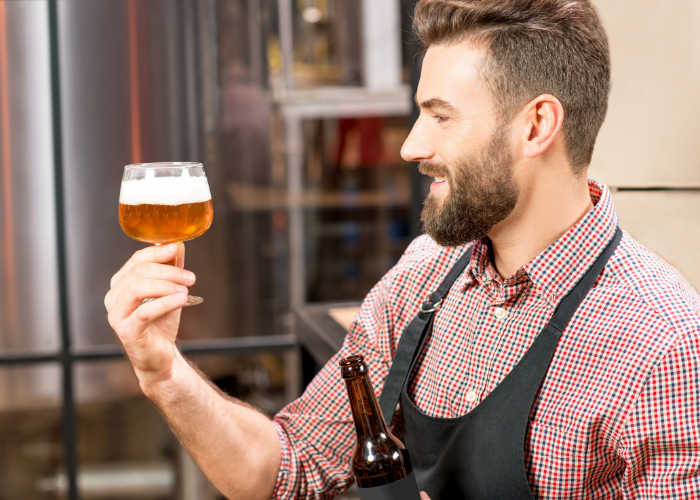
The science of beer
August 25, 2023
To the naked eye, beer appears to be a simple beverage consumed by people worldwide. But did you know there is a whole complex science behind the making of this ‘simple liquid’? In today’s article, we will be diving into the science behind beer and exploring the chemistry between the ingredients which deliver a unique, tasty beer.
History
The history of beer is a captivating tale that intertwines with the development of human civilisation. From its ancient origins to the modern craft beer revolution, understanding the historical context of beer is essential to comprehend the science behind its creation. Beer's roots can be traced back thousands of years, with evidence of its existence dating back to ancient civilisations such as Mesopotamia and ancient Sumeria. These early beer-makers discovered that grains could be fermented, giving rise to a beverage with intoxicating properties.
As brewing techniques advanced over the years, different cultures began to leave their mark on the development of beer. The Egyptians refined the art of brewing, and beer became a staple in their diet, consumed by both adults and children. In medieval Europe, monastic brewing traditions emerged, with monks perfecting their craft and creating unique beer styles. The Reinheitsgebot, or Beer Purity Law, enacted in Germany in 1516, standardized beer production and laid the foundation for modern brewing practices.
We have a whole article dedicated to the history of beer, so if you’d like to learn more about it be sure to check it out.
Brewing process and ingredients
The brewing process and ingredients form the foundation of the science behind beer production. By understanding the intricacies of each step and the role of various ingredients, you can gain a deeper appreciation for the art and science of brewing. The brewing process begins with malting where grains, typically barley, are soaked in water, allowed to germinate, and then dry. This process activates enzymes and starts converting starches into fermentable sugars. Milled malt is then mixed with hot water in a process called mashing, which allows enzymes to break down carbohydrates into sugars.
The sugary liquid undergoes boiling, during which hops are added. Hops not only contribute bitterness but also impart aroma and act as a natural preservative. Boiling helps extract flavours and aromas from the hops and sterilises the liquid.
Yeast plays a vital role in the brewing process. It consumes the sugars in the wort and converts them into alcohol and carbon dioxide through fermentation. Different strains of yeast yield distinct flavours, aromas, and alcohol levels. Ale yeast, for example, ferments at warmer temperatures, producing fruity flavours, while lager yeast ferments at cooler temperatures, resulting in cleaner and crisper characteristics.
After fermentation, the beer undergoes a conditioning period, allowing flavours to mellow and flavours to harmonise. Carbonation can be achieved naturally through secondary fermentation in the bottle or keg, or through forced carbonation using carbon dioxide.
Just like that, that’s how you make beer. Easy right? Not exactly…

The chemistry behind beer
If you’ve not been wowed already by the science of beer, then we can assure you that’s about to change. The chemistry behind beer is fascinating to say the least. From the conversion of starches into fermentable sugars to the creation of aromatic compounds during fermentation, understanding the chemical reactions at play helps unravel the complexities of beer production.
One crucial chemical process in brewing is mashing, where enzymes present in malted grains break down starches into fermentable sugars. The enzymes then cleave them into shorter, soluble sugar units such as maltose and glucose. The balance between these enzymes and the temperature of the mash influences the fermentability of the sugar and, ultimately, the beer's body and sweetness.
Fermentation is perhaps the most transformative stage from a chemical perspective. Yeast, typically Saccharomyces cerevisiae, consumes fermentable sugars and converts them into alcohol and carbon dioxide through anaerobic respiration. This process, known as alcoholic fermentation, produces the alcohol content of beer. Additionally, yeast produces various flavour compounds, including esters, which contribute to fruity or floral aromas. The fermentation temperature and yeast strain selection greatly influence the balance of these flavour compounds.
The chemistry of beer sounds complicated, right? Don’t worry if you don’t understand - we’re still trying to get our heads around it too!
Next, let’s take you high above the clouds where we discuss the final yet most exciting part…

Beer styles and sensory analysis
Beer styles and sensory analysis is a crucial component to understanding the science of beer. This allows brewers and enthusiasts to sample the finished product and evaluate the different characteristics. It’s important for brewers to understand the characteristics and nuances of various beer styles, as it helps them create or replicate specific profiles, ensuring consistency and quality.
On the other hand, sensory analysis is a systematic approach to evaluating beer through the examination of appearance, aroma, flavour, and mouthfeel. The visual examination will determine the colour, clarity, and foam characteristics; providing initial clues about the beer's ingredients and brewing techniques.
Aroma evaluation involves identifying the various aromatics present, such as malt, hops, yeast-derived compounds, and any off-flavours. The flavour assessment considers taste attributes like sweetness, bitterness, acidity, and the presence of specific flavour notes such as caramel, citrus, or coffee.
Another aspect of the sensory analysis is beer pairing. Just as wine can complement certain dishes, different beer styles can enhance and elevate the flavours of various cuisines. Understanding the flavour profiles, carbonation levels, and other sensory aspects of beer enables brewers to recommend to their customers the best pairing with their beer. This enhances the beer and culinary experience enormously!
Overall, sensory analysis is a vital step in quality control, as it helps detect any off-flavours that might have arisen in production. It also aids in recipe development and fine-tuning, allowing brewers to achieve the desired balance and character in their beers.

And breathe…
We know that was a lot to take in, but we hope you enjoyed reading our latest article on the science of beer. Get in touch with us today if you’re unsure about anything we’ve mentioned.
However, if you’re interested in purchasing a range of craft beers, or you would like to join a craft beer club - reach out to the team today for more information!





